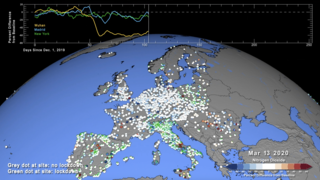Earth
ID: 4820
The Joint Polar Satellite System (JPSS) is the nation’s advanced series of polar-orbiting environmental satellites. JPSS satellites circle the Earth from pole-to-pole and cross the equator 14 times daily in the afternoon orbit—providing full global coverage twice a day. Polar satellites are considered the backbone of the global observing system.
The operational JPSS constellation currently consists of the NASA-NOAA Suomi National Polar-Orbiting Partnership satellite, the technology pathfinder mission for JPSS launched in 2011, and NOAA-20, previously called JPSS-1 and launched in 2017. The next satellite in the series, JPSS-2, is scheduled to launch in the first quarter of 2022. Once it is accepted into the constellation post-launch, JPSS-2 will be renamed NOAA-21 and replace Suomi-NPP.
JPSS represents significant technological and scientific advancements in observations used for severe weather prediction and environmental monitoring. These data are critical to the timeliness and accuracy of forecasts three to seven days in advance of a severe weather event. JPSS is a collaborative effort between NOAA and NASA.
NOAA-20 satellite orbit with Suomi NPP and JPSS-2
The operational JPSS constellation currently consists of the NASA-NOAA Suomi National Polar-Orbiting Partnership satellite, the technology pathfinder mission for JPSS launched in 2011, and NOAA-20, previously called JPSS-1 and launched in 2017. The next satellite in the series, JPSS-2, is scheduled to launch in the first quarter of 2022. Once it is accepted into the constellation post-launch, JPSS-2 will be renamed NOAA-21 and replace Suomi-NPP.
JPSS represents significant technological and scientific advancements in observations used for severe weather prediction and environmental monitoring. These data are critical to the timeliness and accuracy of forecasts three to seven days in advance of a severe weather event. JPSS is a collaborative effort between NOAA and NASA.
Used Elsewhere In
Visualization Credits
Kel Elkins (USRA): Lead Visualizer
Ashley Hume (ASRC Federal System Solutions): Lead Producer
Laurence Schuler (ADNET Systems, Inc.): Technical Support
Ian Jones (ADNET Systems, Inc.): Technical Support
Ashley Hume (ASRC Federal System Solutions): Lead Producer
Laurence Schuler (ADNET Systems, Inc.): Technical Support
Ian Jones (ADNET Systems, Inc.): Technical Support
Please give credit for this item to:
NASA's Scientific Visualization Studio
NASA's Scientific Visualization Studio
Short URL to share this page:
https://svs.gsfc.nasa.gov/4820
Data Used:
Note: While we identify the data sets used in these visualizations, we do not store any further details nor the data sets themselves on our site.
Keywords:
SVS >> Satellite
SVS >> Hyperwall
SVS >> Polar-orbiting
NASA Science >> Earth
https://svs.gsfc.nasa.gov/4820
Data Used:
CelesTrak Spacecraft Orbit Ephemeris
EphemerisKeywords:
SVS >> Satellite
SVS >> Hyperwall
SVS >> Polar-orbiting
NASA Science >> Earth













